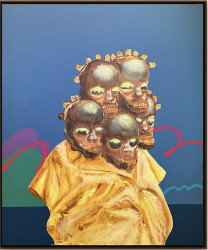
Originally published on metropolis.co.jp on October 2010

Photos by Benjamin Parks


 Maruichi Sennoh stands in the middle of the room twirling a bright blue Japanese parasol. “Anyone can balance a parasol on the palm of their hand with a little practice,” he says, demonstrating this. “Balancing it on the tip of your shoulder takes a little more.” He then takes the umbrella, turns it sideways, and deftly stabilizes the entire object by its razor-thin rim on his chin. “Now this trick. This one I’ve been working on for about 60 years.” At 70 years old, Sennoh, head of the Edo Daikagura Troupe, is the world’s oldest master juggler.
Maruichi Sennoh stands in the middle of the room twirling a bright blue Japanese parasol. “Anyone can balance a parasol on the palm of their hand with a little practice,” he says, demonstrating this. “Balancing it on the tip of your shoulder takes a little more.” He then takes the umbrella, turns it sideways, and deftly stabilizes the entire object by its razor-thin rim on his chin. “Now this trick. This one I’ve been working on for about 60 years.” At 70 years old, Sennoh, head of the Edo Daikagura Troupe, is the world’s oldest master juggler.
Daikagura is a form of kagura, one of the oldest traditional performing arts in Japan, with roots in the Heian period. It is known to many Japanese by its signature act, the shishi-mai (lion dance), but also includes juggling arts like spinning objects on the top of umbrellas. The Edo Daikagura troupe dates back over 400 years and regularly performs at festivals and celebrations to bring good fortune to participants. Complete mastery of all of their arts requires proficiency in dancing, playing instruments, and juggling, all of which entails rigorous daily practice.
Sennoh should know—he was practically born into the business. At the age of 8, he began his career as the adopted trainee of the 12th master of Edo Daigakura, Kagami Kosen. Five years later, he undertook his first major performance—a party for the Showa Emperor in which Sennoh juggled in front of the entire imperial family. Although only 13 years old and performing for what could be called the most intimidating audience in all of Japan, he only dropped his tools once. “After the performance, my father told me it was good that I made that mistake. If I hadn’t, he said, they would have thought I was a god.”
While one might hesitate to call Sennoh’s appearance divine, he’s certainly one of the most energetic ojisan in Tokyo. He also happens to be the most adept member of his troupe. Much of Sennoh’s repertoire involves taking traditional Japanese objects—umbrellas, balls of string, teapots—and manipulating them in amazing ways. “Daikagura is an art for the common people and common objects lie at its soul,” he says as he twirls an umbrella in his hands. “Taking the ordinary and making it extraordinary is what we do.”
Since his imperial debut, Sennoh and his troupe have performed in venues from Manila to Munich and even Las Vegas. “Foreign audiences love us because of the uniqueness of our art,” he says.
The biggest difference between daikagura practitioners and typical jugglers is their adaptability. The troupe claims it can perform its act in any space, no matter how small the stage or how low the ceiling may be. This is primarily possible because, for the most part, practitioners do not move their feet as they perform. They compensate by keeping a straight backbone—similar to Japanese martial artists. “Being based in Tokyo will do that to your act,” Sennoh says with a laugh. “There’s no space in this city! We can perform in sushi shops, bathhouses, geisha teahouses. You name it, we’ve done it.”
All performers must also execute their act in kimonos, which adds additional difficulty by restricting movement significantly. “Jugglers in America, they throw the balls and clubs under their legs, right?” says Sennoh. “We can’t do that—the kimono would get in the way.” Yet the long sleeves of the kimono do have the benefit of accentuating the moves of each performer as they balance, twirl and dance.
The traditional equipment used in daikagura adds another layer of difficulty. “In addition to everyday objects like teapots or umbrellas, we have to make older objects from a previous generation ourselves, like te-mari [decorative balls of string],” Sennoh explains. “Western juggling objects are made to be juggled; they spin and fly through the air easily. Not so with our stuff. The teapot that my disciple balances on a stick is just that—a teapot. And if he drops it, it will break, just like a regular teapot.” (Incidentally, part of the reason the teapot trick is so difficult is because the stick is held in the performer’s mouth.)
Mistakes like these do happen during the performance, and the master must be prepared. “I do the running commentary during our acts, and if someone screws up, it’s my job to make sure the audience thinks it’s funny,” he explains. “If I say something like, ‘He did that on purpose!,’ people forget the mistake and focus on the act.” Ensuring that the patter stays with the performance is an important part of daikagura.
Although he may be the best juggler in Japan, Sennoh spends more of his time teaching than he does performing. Leading his troupe and grooming a successor has limited his own appearances to roughly once a month. Yet he has no plans to stop anytime soon. “Retirement? Ha! In our world, you work until you drop. We’re the only people doing this stuff in the world; unless I pass on my skills to the next generation, they’ll disappear.”
“Besides,” he says with a laugh, “if I retired, what else would I do? Dancing and juggling are the only things I can do to put food in my belly. This is how I earn my meals and I’ll do it through my 80s if I have to!”
Shishi-mai

The main act of the Edo Daikagura troupe is the shishi-mai, or Japanese lion dance. Believed to have originated in China, it’s performed alongside Shinto rituals at New Year’s celebrations, wedding ceremonies and other festivities. The troupe’s style is unique in Japan in that two performers—not just one—control the lion’s movements. The lion head pictured has been in use since the Meiji era and is traditionally passed down from the head of the school to his successor.
Bachi

These sticks are the most basic item in the troupe’s kyoku-gei, or juggling acts. While similar in function to the juggling clubs used in Western countries, they differ in that they’re not balanced for weight, making throws more difficult. They also cannot be bought in a shop—the head of the troupe makes them on his own lathe.
Dobin and Kuwae-bachi

Look ma, no hands! Members of the Daikagura troupe skillfully balance and throw this teapot into the air using nothing but a stick held between their teeth. Mastering this trick takes a lot of time—and expense. “We use a real teapot, just like old hibachi stoves in the Meiji era,” says Sennoh. “It’s very thin, so not even a carpeted floor will save it if you mess up.”
Bangasa

This well-known trick involves spinning various objects on a Japanese-style umbrella. By tilting the umbrella forward while spinning it in the opposite direction, the performer creates an effect similar to running down an ascending escalator. Objects to be spun range from metal rings to porcelain cups.
Dosu

These juggling knives were originally imported into Japan by the tenth leader of the troupe in the Meiji era; he later adapted them into the Japanese tradition. They are heavier than the wooden bachi—and much less forgiving for beginners!
Hitotsumari

Although this large ball of string looks simple enough, manipulating it with two dimpled bachi sticks is the hardest trick in the troupe’s repertoire. A master can appear as if he has strung the ball to the sticks as they fly together and separate seemingly at will. The act takes a minimum five years to learn.
- The Edo Daikagura troupe holds a workshop each Thursday from 5:30-9pm at the Bunkyo Ward Community Center. 4-15-14 Hongo, Bunkyo-ku. Nearest stn: Korakuen, exit A2. Registration fee (1st time only): ¥5,000. Class fee: ¥2,000 (¥1,000 under 18 or over 60). Classes are normally held on the third floor. (Look for the jugglers.)
- For more info, see www.edo-daikagura.com or email office@edo-daikagura.com. Tel: 03-3813-6220. (The troupe says: “Our English is very poor. So, please use easy sentences!”)
- On November 6, the Brown University Club of Japan will host Daikagura!, a family-themed event featuring the Edo Daikagura troupe and an exclusive 30min Q&A with leader Maruichi Sennoh. 1:30-4:30pm. Sendagaya Community Center. 1-1-10 Jingumae, Shibuya-ku. Nearest stn: Harajuku or Meiji-Jingumae. Cost: ¥2,500 (¥1,000 for children 12 and under). A portion of the proceeds will benefit Polaris Project, a Tokyo-based NGO combating human trafficking. RSVP: daikagura@bucj.org. Space is limited, so send your RSVP early.







